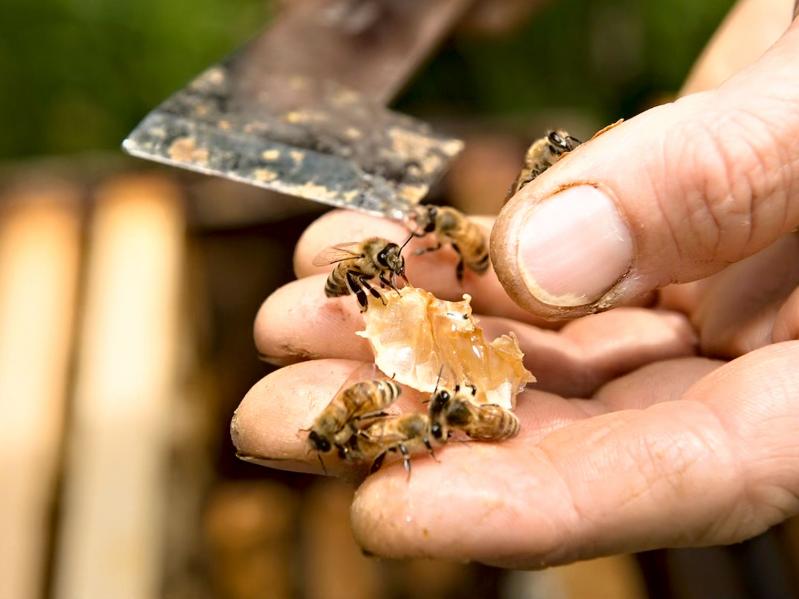“I know you can’t print this in the newspaper, but you should be scared shitless,” Chris Kelly, a professional beekeeper who is the owner of North Fork Promised Land Apiaries, said when asked about the massive die-off of honeybees this winter. He owns 250 hives and manages 100 others for clients, including 10 behind the newly reopened Sagaponack General Store.
“This is the first time in history that professionals lost more bees than hobbyists,” he said. That’s significant because professional beekeepers are known to be obsessed with their bees. “The health of their bees is their health. Quite honestly, they don’t have a clue why it happened.”
According to the Cornell Chronicle, the university’s bee experts are working to identify the cause of the “unprecedented managed honeybee losses,” which Scott McArt, an associate professor of entomology and program director for the Dyce Lab for Honey Bee Studies, in the College of Agriculture and Life Sciences, said “will be the biggest loss of honeybee colonies in U.S. history.”
“The big commercial beekeepers started to look at their hives in late January to see who was strong enough to pollinate the almond crop in California,” said Mary Woltz, the beekeeper behind Bees’ Needs apiaries, in Sag Harbor. “They found catastrophe, losing 60 to 100 percent of their hives.”
You’d be hard pressed to find a beekeeper who is more attentive to her hives than Ms. Woltz. She knows a hive is having trouble if the tone of its buzzing changes. Still, since 2019, she says she’s been losing roughly a third of her hives each year. The Chronicle reports that average recent losses of hives nationally have been 60 percent, leading to a financial loss of at least $139 million.
“My entry to beekeeping was a result of the first real collapse in the honeybee industry, when the varroa mite arrived in the late 1980s,” she said. In 2006, colony collapse disorder struck, and what was bad grew worse. “It was the bee apocalypse and so beekeepers started keeping more detailed records. This winter’s loss is the greatest since then.”
It’s not clear what’s causing colony collapse disorder, or how it spreads, but Ms. Woltz said she’s been careful about importing bees, doing so only twice over the last two decades. “I was trying to get my bees to adapt to the local conditions. That was my goal. The big love fest in California, where two-thirds of honeybee colonies are mixing accelerates the spread of the problem. If something is in one place, it’s not going to be long before it’s everywhere.”
“I blame varroa destructor for everything, including if I run out of gas in my truck,” joked Mr. Kelly. “But it does feel like something has changed. There is, without a doubt, environmental pressure. Outside of the mite, we’ve fractured forage areas. Take each house that’s built. It changes the habitat. It changes the forage. We’re starving our pollinators. The second huge stressor is the amount of pesticide material that is applied in Suffolk County. It’s the highest in New York State.”
Mr. Kelly said that before the varroa mite, a beekeeper might expect to lose 10 percent of hives each winter. This year, he lost 30 percent. However, the number is worse than it sounds. For the past decade, he’s experimented with keeping his overwintering hives indoors, climate controlled, to help control environmental risks. This year, of the 68 hives he kept indoors, 66 survived. That means of his outside hives, a far greater percentage than 30 percent were lost.
Unlike us humans, the critters can’t scroll away from the doom. Bees, birds, fireflies, fish: all struggling. The good news is, by supporting bees with some simple changes, you can support all.
“Anybody can plant pollinator friendly plants,” said Mr. Kelly. “That is the first thing to do. Second thing is to lose our love affair with pesticides and herbicides. Awareness alone is helpful.”
Ms. Woltz said it’s important for people to diversify planting on their properties (“Early bloomers are particularly important”), have a source of water, and to wait until late spring to “clean up” their yards.
“Water is a huge thing. Have a varied depth. If you have a bird bath, make a little ‘bee beach’ in it so bees can feed without drowning,” she recommends. “Another important thing to remember: Bushes and trees will give more bang for the buck, there are more blossoms on them. A wildflower meadow half a soccer field has the equivalent nectar of one mature linden tree in bloom. Just stopping to harm is not enough at this point. We’re obliged to help.” For those interested in supporting bees, she also recommends joining a club.
Moira Alexander is the president of the Long Island Beekeepers Club (longislandbeekeepers.org), the oldest such club in New York State, which started in the 1940s. “Long Island beekeepers have done relatively well,” she said, but agrees action is necessary.
“Take your big green lawn and just take a strip five feet across and then put in native plants that are going to attract pollinators. A simple pollinator garden, a circle in the middle of your lawn with a bird bath and 10 different plants will provide a food source. If you have a dandelion, and you must get rid of it, at least wait until the bloom is done. They’re the first pollen flower. We used to make dandelion chains and hold buttercups under our chins. When did that become so horrible?




